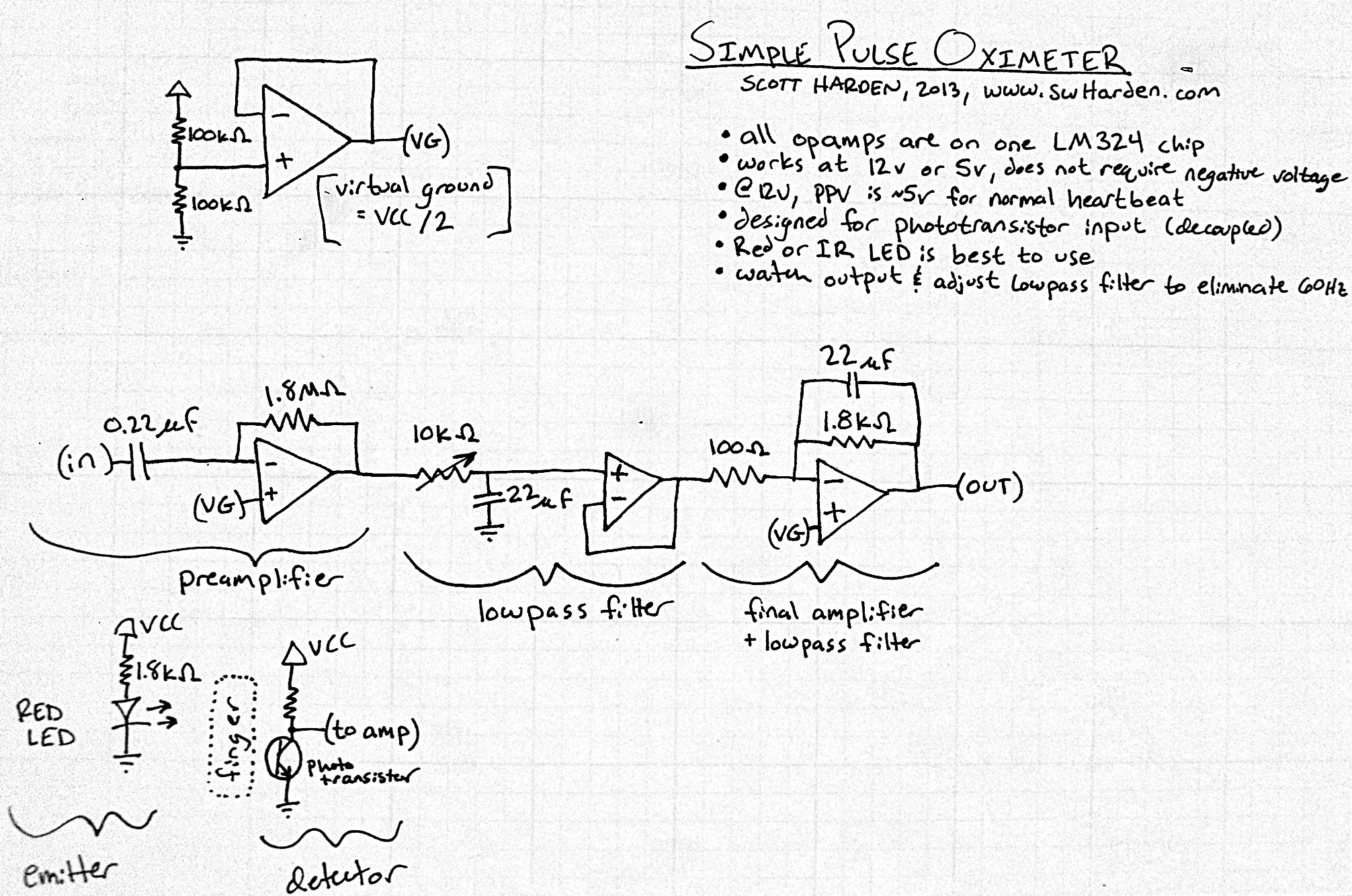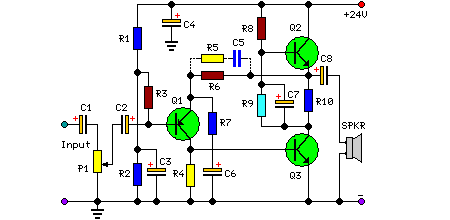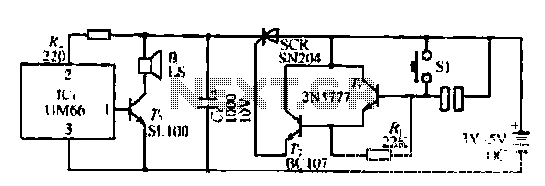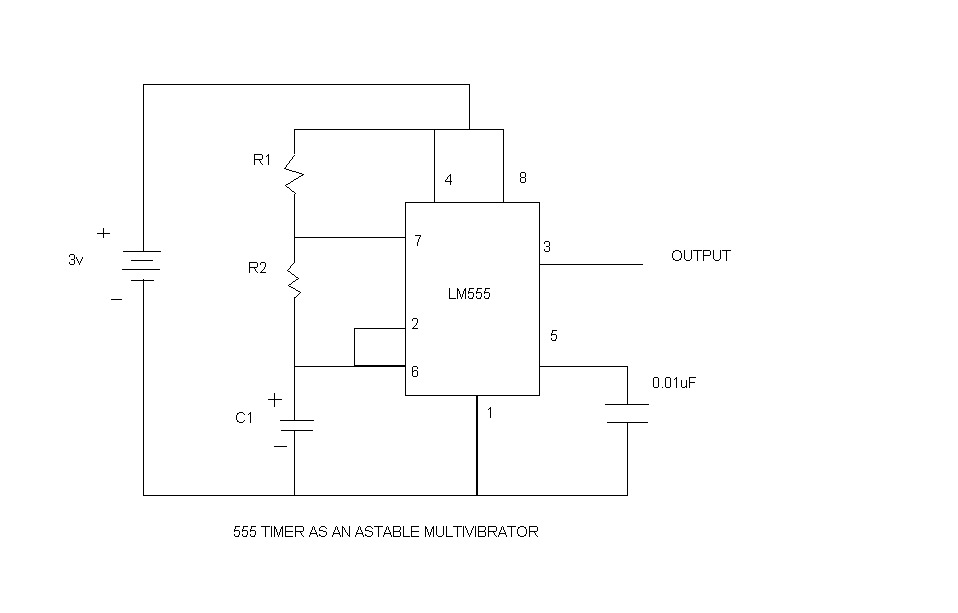
Pulse meter circuit

The input capacitor for the phototransistor at the bottom is responsible for feeding the operational amplifier (op-amp). However, the output from the phototransistor consistently remains between ground (GND) and the supply voltage (Vcc). The necessity for an input capacitor arises because the phototransistor may not be switching completely on and off. Instead, it likely produces a slight variation in response to the minor changes in transmitted light during a heartbeat. The first op-amp stage is configured for high gain due to a large feedback resistor. The AC coupling allows the feedback to set a linear operational point for the first stage, enabling it to amplify the small fluctuations from the phototransistor. While it is acknowledged that the capacitor helps isolate the circuit from the virtual ground, this is not the sole reason for its presence. For instance, even if the virtual ground were removed and the circuit powered with a bipolar supply, the AC coupling capacitor would still be necessary. Ambient light can cause the transistor to operate in a small linear region, leading to small fluctuations on the DC level, likely just a few microvolts. The AC input capacitor will eliminate this bias induced by the LED, allowing for proper amplification of the signal.
The circuit design features a phototransistor connected to an operational amplifier, where the phototransistor serves as a light sensor that responds to variations in light intensity. The input capacitor connected to the phototransistor plays a critical role in ensuring that only the alternating current (AC) components of the signal are fed into the op-amp, effectively blocking any direct current (DC) bias that may distort the signal. This bias can arise from ambient light, which may inadvertently cause the phototransistor to operate in a partially conductive state, resulting in unwanted DC levels that obscure the desired AC signal.
The operational amplifier is configured in a non-inverting mode, utilizing a large feedback resistor to achieve substantial gain. This configuration is essential for amplifying the minute variations in light detected by the phototransistor, particularly those changes associated with physiological signals such as heartbeats. The AC coupling capacitor ensures that the op-amp can function within its linear range, allowing it to amplify small signal fluctuations without being affected by the DC bias.
In scenarios where the virtual ground is not employed, or if a bipolar supply is used, the importance of the AC coupling capacitor remains unchanged. It is vital for maintaining signal integrity and ensuring that the op-amp can effectively amplify the small AC signals generated by the phototransistor. The overall circuit design emphasizes the importance of careful component selection and configuration to achieve reliable and accurate signal amplification in the presence of varying ambient light conditions.The input cap for The phototransistor at the bottom is what feeds the opamp. But the output from the phototransistor is always between GND and Vcc. So why the need for an input capacitor It`s most likely there because the photo transistor is not being switching fully on and off. It is likely giving a very small "wiggle" in response t o the small change in transmitted light during a heartbeat. The first op amp stage is configured for a lot of gain with that large feedback resistor. The AC coupling allows the feedback to establish a linear operation point for the first stage to amplify the small blips from the phototransistor. while I kinda agree that it`s probably needed to isolate it from the virtual ground, that`s not the only reason.
For example, if you removed the virtual ground and powered the circuit with a bipolar supply, you would still need the AC coupling capacitor. for the reasons stated by w2aew. The ambient light is going to bias the transistor on in a small linear region. w2aew described it just about perfectly, it will be like little wiggles on the DC level, probably just a few microvolts, and the AC input capacitor will remove this BIAS caused by the LED and allow the signal to be amplified.
🔗 External reference
The circuit design features a phototransistor connected to an operational amplifier, where the phototransistor serves as a light sensor that responds to variations in light intensity. The input capacitor connected to the phototransistor plays a critical role in ensuring that only the alternating current (AC) components of the signal are fed into the op-amp, effectively blocking any direct current (DC) bias that may distort the signal. This bias can arise from ambient light, which may inadvertently cause the phototransistor to operate in a partially conductive state, resulting in unwanted DC levels that obscure the desired AC signal.
The operational amplifier is configured in a non-inverting mode, utilizing a large feedback resistor to achieve substantial gain. This configuration is essential for amplifying the minute variations in light detected by the phototransistor, particularly those changes associated with physiological signals such as heartbeats. The AC coupling capacitor ensures that the op-amp can function within its linear range, allowing it to amplify small signal fluctuations without being affected by the DC bias.
In scenarios where the virtual ground is not employed, or if a bipolar supply is used, the importance of the AC coupling capacitor remains unchanged. It is vital for maintaining signal integrity and ensuring that the op-amp can effectively amplify the small AC signals generated by the phototransistor. The overall circuit design emphasizes the importance of careful component selection and configuration to achieve reliable and accurate signal amplification in the presence of varying ambient light conditions.The input cap for The phototransistor at the bottom is what feeds the opamp. But the output from the phototransistor is always between GND and Vcc. So why the need for an input capacitor It`s most likely there because the photo transistor is not being switching fully on and off. It is likely giving a very small "wiggle" in response t o the small change in transmitted light during a heartbeat. The first op amp stage is configured for a lot of gain with that large feedback resistor. The AC coupling allows the feedback to establish a linear operation point for the first stage to amplify the small blips from the phototransistor. while I kinda agree that it`s probably needed to isolate it from the virtual ground, that`s not the only reason.
For example, if you removed the virtual ground and powered the circuit with a bipolar supply, you would still need the AC coupling capacitor. for the reasons stated by w2aew. The ambient light is going to bias the transistor on in a small linear region. w2aew described it just about perfectly, it will be like little wiggles on the DC level, probably just a few microvolts, and the AC input capacitor will remove this BIAS caused by the LED and allow the signal to be amplified.
🔗 External reference





